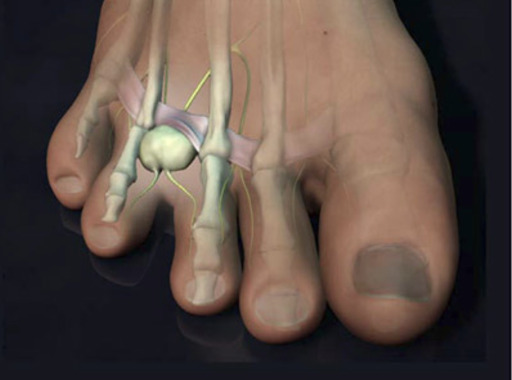WHAT IS MORTON’S NEUROMA?
Morton’s neuroma is a painful state that affects the ball of your foot, most commonly the region between your third and fourth toes. Morton’s neuroma might feel as if you are standing on a pebble in your shoe or on a fold in your sock.
Morton’s neuroma implicates a thickening of the tissue around one of the nerves leading to your toes. This could cause a sharp, burning pain in the ball of your foot. Your toes also might sting, burn or feel numb.
High-heeled shoes have been connected to the development of Morton’s neuroma. Many people feel relieved when switching to lower-heeled shoes with wider toe boxes. Sometimes corticosteroid injections or surgery might be required.

MORTON’S NEUROMA SYMPTOMS
Normally, there is no outward sign of this condition, like a lump. Instead, you might experience the following symptoms:
- A feeling as if you are standing on a stone in your shoe
- A burning pain in the ball of your foot that might radiate into your toes
- Tingling or numbness in your toes
WHEN SHOULD YOU SEE A DOCTOR?
It is best not to ignore any foot pain that lasts longer than a few days. See your doctor or primary care physician if you experience a burning pain in the ball of your foot that is not improving, despite changing your footwear and modifying activities that might cause stress to your foot.
MORTON’S NEUROMA CAUSES
Morton’s neuroma seems to happen in response to irritation, pressure, or injury to one of the nerves that lead to your toes.

MORTON’S NEUROMA RISK FACTORS
The factors that seem to contribute to Morton’s neuromas include:
High heels – Wearing high-heeled shoes or shoes that are tight or ill-fitting could place extra pressure on your toes and the ball of your foot.
Specific sports – Participating in high-impact athletic activities like jogging or running might subject your feet to repetitive trauma. Sports that feature tight shoes, like snow skiing or rock climbing, could put pressure on your toes.
Foot deformities – People who have bunions, hammertoes, high arches, or flat feet are at greater risk of developing Morton’s neuroma.
The symptoms may worsen after prolonged activities like sitting, walking or running and might get better once you rest or after lying down.
MORTON’S NEUROMA DIAGNOSIS
During the examination, your doctor or primary care physician will press on your foot to feel for a mass or tender spot. There might also be a feeling of “clicking” between the bones of your foot.
Imaging tests
Some imaging tests are more effective than others in the diagnosis of Morton’s neuroma:
X-rays – Your doctor or primary care physician is likely to order X-rays of your foot, to rule out other causes of your pain like a stress fracture.
Ultrasound – This technology uses sound waves to create real-time pictures of internal structures. Ultrasound is especially good at revealing soft tissue abnormalities, like neuromas.
Magnetic resonance imaging (MRI) – Using radio waves and a strong magnetic field, magnetic resonance imaging (MRI) also is good at visualizing soft tissues. But it is an expensive test and usually indicates neuromas in people who have no symptoms.

MORTON’S NEUROMA TREATMENT
Treatment depends on the seriousness of your symptoms. Your doctor or primary care physician will likely recommend trying conservative approaches first.
Therapy
Arch supports and foot pads fit inside your shoe and help lower pressure on the nerve. These could be purchased over-the-counter, or your doctor or primary care physician might prescribe a custom-made, individually designed shoe insert molded to fit the exact contours of your foot.
Surgical and other procedures
If conservative treatments have not helped, your doctor or primary care physician may recommend:
- Injections – Some people are helped by the injection of steroids into the painful region.
- Decompression surgery – In some cases, surgeons could relieve the pressure on the nerve by cutting nearby structures, like the ligament that interconnects some of the bones in the front of the foot.
- Removal of the nerve – Surgical removal of the growth might be required if other treatments fail to provide pain relief. However, surgery is generally successful, the procedure could result in permanent numbness in the affected toes.
If you or anyone you know is suffering from Morton’s neuroma, our expert providers at Specialty Care Clinics will take care of your health and help you recover.
Call 469-545-9983 to book a telehealth appointment for an at-home check-up.
